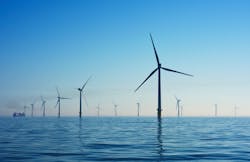DOE Awards $72M for Manufacturing and Deployment of Wind and Water Energy Technologies
The U.S. Department of Energy (DOE) has awarded $72 million for three sets of projects to innovate manufacturing processes for wind and water technologies and accelerate the equitable and sustainable deployment of offshore and land-based wind energy.
As part of President Biden’s Investing in America agenda, the funding includes $27 million from the Bipartisan Infrastructure Law for 15 projects to support research, development, and community engagement to accelerate the deployment of offshore and land-based wind energy. $45 million will be allocated to 14 projects to make domestic manufacturing of these technologies quicker and less expensive.
The grants will streamline the processes to create the tools to produce wind and hydropower, reduce barriers for communities deploying offshore and distributed wind energy technologies, and reduce the impact on wildlife.
“The Biden-Harris Administration is committed to deploying wind turbines that harness the clean power of wind while at the same time ensuring the clean energy transition is built in America’s factories,” said U.S. Secretary of Energy Jennifer M. Granholm. “Wind energy is among the most affordable and sustainable clean energy resources in the United States—this funding will demonstrate how wind power can benefit different communities and strengthen our domestic supply chain through innovation.”
The funding will enable manufacturers to make enormous wind and water turbine pieces, such as hubs and bedplates, which are estimated to increase five times in the next decade to meet America’s clean energy goals.
The goals of these projects support the DOE's Offshore Wind Strategy, the Offshore Wind Supply Chain Road Map, the interagency Floating Offshore Wind Shot, and the priorities identified in the DOE’s 2022 Wind Energy Supply Chain Deep Dive Assessment.
The Biden-Harris Administration aims to deploy 30 GW of offshore wind energy by 2030 and achieve a net-zero carbon economy by 2050. Wind energy deployment should increase from the current average of 7 GW per year to between 70 and 145 GW per year by the end of the decade to achieve a fully decarbonized power sector by 2035.
The project funding details are as follows:
Four projects worth $8.5 million selected under High-Voltage Direct Current for Offshore Wind Transmission will support standards for HVDC transmission for offshore wind, develop and validate innovative controls to ensure reliability and compatibility with alternating current and direct current, and identify and address gaps in education and workforce training.
- GE Research – Niskayuna, New York – $3,000,000
- Oak Ridge National Laboratory – Oak Ridge, Tennessee – $2,800,000
- DNV Energy USA – Dallas, Texas – $2,000,000
- Iowa State University – Ames, Iowa – $700,000
A project to International City County Management Association, Washington, D.C., worth $4.5 million under Advancing Deployment of Distributed Wind, will improve permitting processes to make distributed wind more accessible to communities where it can be cost-effectively and equitably deployed.
Five projects worth $6.5 million selected under Offshore Wind Energy Social Science Research will help characterize the economic and other impacts of offshore wind development on local communities and build capacity for communities to better participate in and benefit from offshore wind development.
- Oregon State University – Corvallis, Oregon – $2,500,000
- University of Rhode Island – Kingston, Rhode Island – $2,500,000
- Gulf of Maine Research Institute – Portland, Maine – $500,000
- Yurok Tribe – Klamath, California – $500,000
- Sandia National Laboratories – Albuquerque, New Mexico – $500,000
Five projects worth $7.5 million selected under Bat Deterrent Technology Development will advance bat deterrent technologies by supporting bat behavioral research, technology development, and field testing.
- Bat Conservation International – Austin, Texas – $2,500,000
- Electric Power Research Institute – Palo Alto, California – $2,300,000
- Boise State University – Boise, Idaho – $1,000,000
- National Renewable Energy Laboratory – Golden, Colorado – $1,000,000
- Iowa State University – Ames, Iowa – $750,000
A project given to GE Research, Niskayuna, New York, worth $14,900,000 under Near Net Shape Manufacturing, will innovate domestic production of large metallic near net shape components. It will focus on the manufacturing practices of large-scale machinery to make enormous hydropower equipment using 3D printing, reducing the production cost by 20% and lead time by four months.
Four projects worth $7,996,328 under Large Wind Blade Additive Manufacturing are focused on the integration of additive manufacturing techniques specific to the production of large wind blades, enhancing efficiency and adaptability in the blade creation process.
- Collaborative Composite Solutions – Knoxville, Tennessee – $2,000,000
- Oak Ridge National Laboratory – Oak Ridge, Tennessee – $2,000,000
- Purdue University – West Lafayette, Indiana – $1,999,578
- Virginia Polytechnic Institute and State University – Blacksburg, Virginia – $1,996,750
Three projects worth $5,999,845 under Additive Manufacturing of Wind Turbine Components will employ advanced additive manufacturing approaches to produce critical components for wind turbines, streamlining production and allowing for innovative design adaptions.
- Orbital Composites Inc. – San Jose, California – $2,000,000
- RCAM Technologies – Boulder, Colorado – $2,000,000
- GE Research – Niskayuna, New York – $1,999,845
Six projects worth $15,891,793 under Advanced Manufacturing, Materials, and Sustainability will focus on state-of-the-art manufacturing processes, materials research, and sustainable practices for the development and production of large wind blades. Key areas of interest include Automation, Digitalization, Sustainability, and Modular Blade Construction/Joining.
- University of Massachusetts Lowell – Lowell, Massachusetts – $3,000,000
- University of North Dakota – Grand Forks, North Dakota – $3,000,000
- GE Research – Niskayuna, New York – $2,999,995
- University of Delaware – Newark, Delaware – $2,970,353
- The University of Texas at Dallas – Richardson, Texas – $2,721,445
- WEI7 LLC – Onalaska, Texas – $1,200,000
